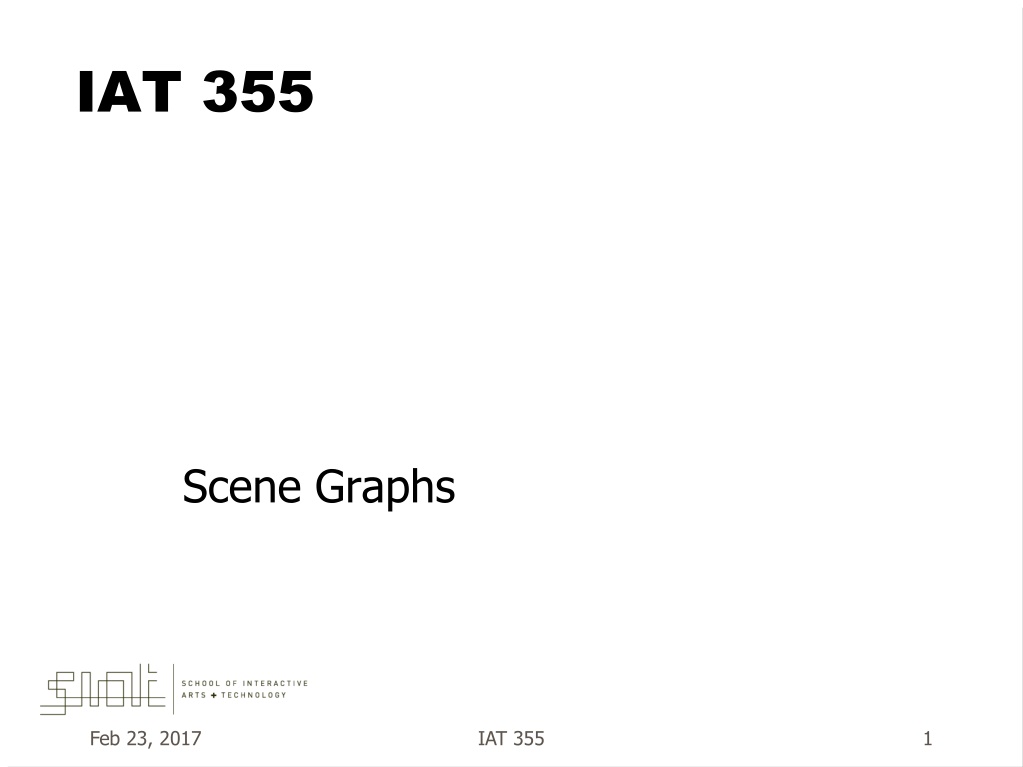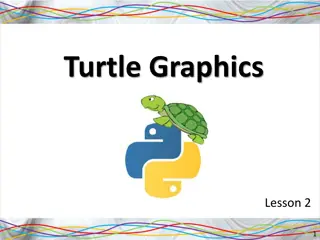Understanding Graphics Scene Structures and Rendering Techniques
This content delves into the world of computer graphics, focusing on scene graphs, immediate mode graphics, OpenGL objects, imperative and object-oriented programming models, and Java implementation. It explains the storage and manipulation of graphic scenes, drawing techniques, and different programming paradigms for rendering objects effectively.
Download Presentation

Please find below an Image/Link to download the presentation.
The content on the website is provided AS IS for your information and personal use only. It may not be sold, licensed, or shared on other websites without obtaining consent from the author. Download presentation by click this link. If you encounter any issues during the download, it is possible that the publisher has removed the file from their server.
E N D
Presentation Transcript
IAT 355 Scene Graphs Feb 23, 2017 IAT 355 1
Scene Graphs A data structure that stores information about a graphics scene Each node has information that structures the interpretation of child nodes Feb 23, 2017 IAT 355 2
Computer Graphics In Processing we use immediate mode graphics When we define a geometric object: Call its drawing code glPushMatrix() glBegin( GL_TRIANGLES ); glVertex3f( 1.0, 2.0, 3.0 ); ... glEnd(); glPopMatrix(); Feb 23, 2017 IAT 355 3
Immediate Mode Graphics objects are not retained once they are drawn To redraw the scene, must reexecute the code Makes sense, because the screen needs redrawing when new info arrives Feb 23, 2017 IAT 355 4
OpenGL and Objects OpenGL has a weak notion of objects Eg. Consider a red cube Model the cube with squares Color is determined by OpenGL state (current color, current lighting) Not really an object Feb 23, 2017 IAT 355 5
Imperative Programming Model Example: rotate the cube Application sends cube data to the graphics subsystem The graphics subsystem maintains state Current rotation, translation... The rotate function must know how the cube us represented Vertex list Edge list Feb 23, 2017 IAT 355 6
Object Oriented Graphics In OO graphics, the representation is stored with the model The application sends updates to the cube model, which stores state such as transformation, color The object contains functions that allow it to transform itself Feb 23, 2017 IAT 355 7
Java The obvious means to do this is to store objects in instances of classes Methods do transformation and trigger drawing calls Feb 23, 2017 IAT 355 8
Cube object Create an object that allows us to store rotation, translation, color... Cube myCube ; myCube.color[0] = 1.0 ; myCube.color[1] = 0.0 ; ... myCube.matrix [0][0] = 1.0 ; .... Feb 23, 2017 IAT 355 9
Cube object functions Also want common functions to act on the cube s data: myCube.translate( tx, ty, tz ); myCube.rotate( r, 1.0, 0.0, 0.0 ); myCube.setColor( r, g, b); Draw it! myCube.render(); Feb 23, 2017 IAT 355 10
class cube { public: float color [3] ; float matrix[4][4] ; private: //implementation } Feb 23, 2017 IAT 355 11
The Implementation Can choose any old way of representing the cube Vertex list, polygons... Private stuff accesses the public piece Render method makes OpenGL calls Feb 23, 2017 IAT 355 12
Other Objects Other types of objects are: 3D Cameras 3D Lights Also non-geometric things Materials, colors Matrices (storing geometric transformations) Feb 23, 2017 IAT 355 13
Application cube myCube ; material plastic ; myCube.setMaterial( plastic ); camera frontView; frontView.position( x, y, z ); Feb 23, 2017 IAT 355 14
Scene Descriptions If you can represent all scene elements as objects Cameras Lights Material Geometry Put it all in a tree and traverse the tree Render scene by traversal Feb 23, 2017 IAT 355 15
Scene Graph Feb 23, 2017 IAT 355 16
Scene Graph glPushAttrib glPushMatrix glColor glTranslate glRotate Object1 glTranslate Object2 glPopMatrix glPopAttrib ... Feb 23, 2017 IAT 355 17
Scene Graph Traversal Similar to preorder traversal of binary tree Visit a node Activate the node -- pushMatrix/Attrib Vist all children in child order UNActivate node -- popMatrix/Attrib Feb 23, 2017 IAT 355 18
Separator nodes Necessary to mark places where attribute changes take place Where the OpenGL push/pop live Advantage: You can write a universal traversal algorithm Traversal order must be predictable In OpenGL, state changes stick around Setting color sticks until the next color change Feb 23, 2017 IAT 355 19
Scene Graphs There is a very important strategy: Transform Code into a Data Structure What was previously a bunch of OpenGL calls is now: Graph nodes of various kinds Each node type has well-defined rules Feb 23, 2017 IAT 355 20
Scene Graph Hierarchy Changes to Parent nodes affect all children Translate of a sub-tree moves all of its nodes Specify this large-scale change in one place The scene graph rules handle the rest Feb 23, 2017 IAT 355 21























